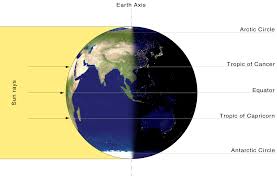
记忆方法
为了记忆单词“equinox”,可以采用“形象联想法”,构造一个与“equinox”(春分或秋分)相关的场景:
想象地球正好位于赤道上,太阳光线垂直射向地球,这意味着白天和黑夜的长度在两极附近和赤道上是相等的,象征性地,你可以在“equator”(赤道)上的“equi”(平等)处找到“no”(没有),即白天和黑夜没有长短之分,这就是“equinox”。
想象地球正好位于赤道上,太阳光线垂直射向地球,这意味着白天和黑夜的长度在两极附近和赤道上是相等的,象征性地,你可以在“equator”(赤道)上的“equi”(平等)处找到“no”(没有),即白天和黑夜没有长短之分,这就是“equinox”。
以上内容由AI生成, 仅供参考和借鉴
中文词源
equinox 春分,秋分
equ-, 平等,相等。-nox, 夜,词源同night, nocturne.
英语词源
- equinox (n.)
- c. 1400, "point at which the sun crosses the earth's equator, making day and night of equal length everywhere," from Old French equinoce (12c.) or directly from Medieval Latin equinoxium "equality of night (and day)," from Latin aequinoctium, usually in plural, dies aequinoctii "the equinoxes," from aequus "equal" (see equal (adj.)) + nox (genitive noctis) "night" (see night). The Old English translation was efnniht. Related: Equinoctial.
权威例句
- 1. The Autumnal Equinox is the best time for wheat - sowing.
- 秋分种麦最相宜.
- 2. In the Chinese calendar, the Spring Equinox always occurs in the second month.
- 在中国历法中,春分总是出现在2月。
- 3. The other point of intersection of equator and the ecliptic is called the Autumnal Equinox.
- 赤道和黄道的另一个相交点叫作秋分点.
- 4. The zero point is the Vernal Equinox, also called the point of Aries.
- 零点是春分点, 也叫做白羊座点.
- 5. During a tropical year the sun moves from Vernal Equinox to Vernal Equinox.
- 在一个回归年内,太阳从春分点转回到春分点.